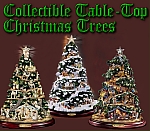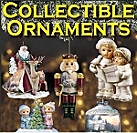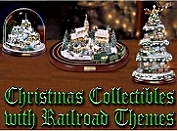|
Don't Try This At Home (Anymore) - Dangerous Decorations People Used To Use, from Family Christmas OnlineTM
While I was recently researching an article about vintage Christmas tree ornaments, I couldn't help thinking about old Christmas decorations that few people in their right mind would use today. Of course I grew up back in the days when if you broke a thermometer, you got to play with the mercury barehanded until it rolled between the floorboards and was trapped there forever. So let's just say that our sense of personal risk from the world around us was somewhat lower than it is today.
At any rate, this may seem a little macabre, but what's a trip down memory lane without an occasional recollection of some risk we blissfully ignored and - by the grace of God - survived?
 Real Candles Real Candles
Of course, the most dangerous Christmas tree decorations ever were real candles, considered an essential part of the decorations for much of the 19th and part of the early 20th century. In those days, Christmas tree "stands" were wooden crossbars to which the tree trunk was nailed directly. (The whole notion of standing a tree in something that held water didn't come about until much later.) On the other hand, the tree didn't have to stay dry long. Parents typically decorated the tree on Christmas eve, lit the candles on Christmas morning, and took the tree out a day or so later without ever relighting the candles.
 Also, for most of the 19th century, Christmas trees tended to be small, what we could call tabletop trees today. A 30-36" tree with a dozen candles at the most would probably not endanger your home too much as long as you didn't leave it burning when no one was there to watch it, and you took it down the next day. Also, for most of the 19th century, Christmas trees tended to be small, what we could call tabletop trees today. A 30-36" tree with a dozen candles at the most would probably not endanger your home too much as long as you didn't leave it burning when no one was there to watch it, and you took it down the next day.
But as Christmas trees became more central to family Christmas celebrations, the trees got bigger and started staying up longer, often a week or more. Lighting candles on a five-or-six-foot tree that had been drying out for several days was very risky. No matter how it ignites, a six-foot evergreen tree with dried-out needles can burn so hot and fast that in less than a minute, draperies and furniture across the room will spontaneously burst into flames. Thankfully, water-bearing tree stands and electric Christmas lights have reduced the threat of the tree catching fire, but if it does catch fire, the danger is the same today as it was a century ago.
Early Electic Lighting
 When I was little, the light bulbs screwed into their sockets, and they were wired in a series, so that if one went out, you had to keep changing out the bulbs in the strand until you had found the bad one. On the bright side, there were usually only eight bulbs to a strand, so it didn't take that long. Yes, they did get hot enough to burn your hand if you brushed against one that had been lit a while. And that heat ignited more than one dried-up Christmas tree. When I was little, the light bulbs screwed into their sockets, and they were wired in a series, so that if one went out, you had to keep changing out the bulbs in the strand until you had found the bad one. On the bright side, there were usually only eight bulbs to a strand, so it didn't take that long. Yes, they did get hot enough to burn your hand if you brushed against one that had been lit a while. And that heat ignited more than one dried-up Christmas tree.
 But when electric Christmas tree lighting was introduced, the biggest threat wasn't the lights, it was the wiring they were plugged into. Most houses had 10- or 15-amp service and "knob and tube" wiring, with insulation that heat could cause to break down quickly. But when electric Christmas tree lighting was introduced, the biggest threat wasn't the lights, it was the wiring they were plugged into. Most houses had 10- or 15-amp service and "knob and tube" wiring, with insulation that heat could cause to break down quickly.  And up until about 1940, most rooms had only one electrical outlet (or at the most, two). So the tree's lighting usually went into the same outlet as a radio, a floor lamp, and any other electrically-powered device in the room. By 1940, most living rooms were a maze of extension chords and worse year-round. At Christmas the problem doubled. And up until about 1940, most rooms had only one electrical outlet (or at the most, two). So the tree's lighting usually went into the same outlet as a radio, a floor lamp, and any other electrically-powered device in the room. By 1940, most living rooms were a maze of extension chords and worse year-round. At Christmas the problem doubled.
 Of course the risk of early electric tree lighting causing any sort of fire was lower than the risk of open flames on the tree itself, but there was still a risk. When parallel Christmas tree lights replaced the old serial lights, they were still potentially dangerous. All of these bulbs used more-or-less opaque coatings that kept most of the radiant energy in and made the bulbs get very hot. Of course the risk of early electric tree lighting causing any sort of fire was lower than the risk of open flames on the tree itself, but there was still a risk. When parallel Christmas tree lights replaced the old serial lights, they were still potentially dangerous. All of these bulbs used more-or-less opaque coatings that kept most of the radiant energy in and made the bulbs get very hot.
By the late 1960s, some manufacturers were making "cool lights," which used a transparent coating that trapped far less heat than the old opaque coating. However, they were soon replaced by mini-light strands that were even cooler. So today, the risk of igniting your Christmas tree with the lighting is pretty low unless you let it get very dry. (It's still a good idea to unplug the tree when you're not going to be in the room for a while, though.)
Two other kinds of problems were also related to electric Christmas tree lights.
- A few of the first aluminum tree owners disregarded the warnings about not hanging lights on the things. (But we can't really blame those accidents on the light strands, can we?)
 The pastboard, glitter-covered houses that came from Japan in the early 1930s had holes in the back for poking a Christmas tree lightbulb in. If you put the bulb in the right way, and unplugged the lights when you were not going to be in the room for a while, there was no problem. But occassionally there were problems, almost always very minor. The bulbs they put into modern Christmas village houses are clear, so they stay cooler. Of course, having your buildings made out of ceramic instead of cardboard doesn't hurt the safety factor, either.
(That said, these buildings are making a comeback - look at the links at the bottom of this page for more information.) The pastboard, glitter-covered houses that came from Japan in the early 1930s had holes in the back for poking a Christmas tree lightbulb in. If you put the bulb in the right way, and unplugged the lights when you were not going to be in the room for a while, there was no problem. But occassionally there were problems, almost always very minor. The bulbs they put into modern Christmas village houses are clear, so they stay cooler. Of course, having your buildings made out of ceramic instead of cardboard doesn't hurt the safety factor, either.
(That said, these buildings are making a comeback - look at the links at the bottom of this page for more information.)
Tin Can Key "Icicles"
I don't have a photo of this yet, but when my dad was little, many products that came in cans came with little keys that you would stick into a tab and turn to pull of a strip of metal and open the can. At the end of this process, the key looked like it was wound up in a watch spring. But you could pull the "spring" downward to create a spiral that was shiny on at least the inside. (Some were shiny on both sides). They could also be razor-sharp, so they were dangerous to handle, and especially dangerous to children. But that didn't stop many thousands of families from using this decoration as a "poor man's icicle" before, during and after the Great Depression. And for less affluent families, they were more affordable than the lead foil icycles the rich kids used. Which brings us to:
 Lead Foil Icicles Lead Foil Icicles
When I was growing up, things went onto the Christmas tree in a certain sequence: the lights, then the garland, then the ornaments, then the "icicles." When everyone was satisfied with the arrangement of the ornaments, it was time to for the "frosting" on the cake. We reached into the very bottom of the decoration box and pulled out the last item, an ancient Country Gentleman magazine that had a handful of lead foil icicles every so many pages with the ends hanging out like ribbons in a Bible (they were stored that way to keep them from tangling). Each child would take a handful, being careful not to tangle them, then extricate one icicle at a time to hang on the tree. Breaking one, which was all too easy, was considered a faux pas. Eating fingerfood, like cookies or hard candy, while we hung them was not.
There were hundreds, and by the time we were done, the tree glistened like a frozen waterfall in the sunlight. By the mid-sixties, our friends' trees all had icicles made of sliced acetate sheeting with a reflective coating on one side. But what offended my aesthetic sense was that their parents let them throw out the tree with those icicles still on it. Didn't they know you were supposed to take them off the tree one at a time, then group them into small clusters and fold them reverently into the pages of an ancient magazine?
We stopped using the lead icicles about the same time Vatican II converted the Mass into English. I assumed they were gone, since every member of the family has moved at least twice since those days, and I don't remember them surfacing. Then recently my Dad remembered seeing them somewhere in the boxes the last time he moved. No one knows where they are now, but if they do resurface, I'll make certain they are recycled safely.
So how did we survive our annual "Festival of Lead"? Wasn't it harmful? Well, you should probably know that my two sisters and I have, at last count, nine college degrees among us, so none of us seem to have been permanently diminished in that regard. On the other hand, I have the attention span of a gerbil, so maybe there's something to the warnings after all. What were we talking about? Oh, yes, dangerous Christmas ornaments.
Bubble Lights
 Before there were lava lamps, there were bubble lights, fragile glass tubes filled with heated colored liquid. The original bubble lights used methylene chloride, which didn't have to get very hot to work, but others used oils, which had to be hotter. All of the liquids got hot eventually, and none of them were safe to ingest, especially hot. (Methylene chloride, a common ingredient in paint strippers, isn't even safe to get onto your skin.) Before there were lava lamps, there were bubble lights, fragile glass tubes filled with heated colored liquid. The original bubble lights used methylene chloride, which didn't have to get very hot to work, but others used oils, which had to be hotter. All of the liquids got hot eventually, and none of them were safe to ingest, especially hot. (Methylene chloride, a common ingredient in paint strippers, isn't even safe to get onto your skin.)
Used properly, out of the reach of children, bubble lights weren't really that dangerous - they were certainly far safer than real candles or lead icicles. But in some homes, the phrase "out of the reach of children" has no meaning whatsoever. Most accidents involved broken glass and minor burns from the liquid. A few involved shorting out the light strand as well, which brought the threat, at least, of serious shock. Eventually bubble lights were taken off the market. Whether it was because people had concluded that they were dangerous or that there were so many "copycat" versions that they were no longer profitable, I'm not entirely sure.
Today many collectors still use "real" bubble lights on their vintage-style Christmas trees. A few companies have also introduced a safer version that can't be broken by children as easily as the old ones.
Update for 2013 - In December 2013, I received a long e-mail from a reader chastising me for claiming that bubble lights could be hazardous to children, when I really should have been lecturing parents on how to keep their children under control. Apparently since her children grew up and moved away, her bubble lights have been (as the Brits say) "safe as houses." In case you wondered, I do not recommend allowing small children to have access to Christmas decorations in general, especially those made of glass. But that doesn't mean that hot, somewhat poisonous liquids in fragile glass tubes don't hold more dangers than most.
 Update for 2014 - Asbestos Snow Update for 2014 - Asbestos Snow
My aunt used to have a big packet of white fiberglass that she called "angel-hair" and wrapped around her nativity scene once a year. For me, the stuff was too itchy. But the real danger (as we know now) was snow made out of asbestos fibers. Click here for a gallery of photos of cheerful Christmas packaging holding potentially deadly decorating materials. Just the photos of this stuff make me itch. Thank you, Maria Cudequest, for bringing this page to our attention.
Conclusion
So, was Christmas really all that dangerous a half-century or more ago? Not really. Thankfully, since Americans stopped decorating their Christmas trees with open flames, the vast majority of families have gone for generations without a single mishap related to Christmas decorations. The point of this article isn't that lead foil isn't dangerous or that Christmas is. Rather, I published this article to remind our readers to:
- Think about safety during the holidays - Who knows what decoration going onto the store this month might become the next generation's lead icicles or bubble lights?
- Build new memories with your family - Did this article bring back some good memories, even while we were discussing things that were silly or worse? You'll be surprised what silly decoration or tradition you have today that your kids or grandkids will remember fondly when they have children.
- Thank the Lord who has "brought us safe thus far," and ask Him to give you wisdom to help safeguard the next generation from threats seen and unseen.
- Celebrate Christmas in the ways that seem best to you - Don't worry about what folks a generation from now will think about it.
May God bless each of you and your families this Christmas and bring you safely into the New Year!
Paul
Related Articles on Other Sites
If this article has got you thinking about child safety, or about your own childhood Christmases, here are some related articles I found on other sites.
Other Articles About Christmas Decorations
And here are some of our articles that may get you thinking about decorations that you might actually want in your house.
If you've been reading our pages, you know that we have big things planned, and a lot on our plate, so keep checking back.
And contact
us with any questions or suggestions you have in the meantime.
Paul and Shelia Race
www.familychristmasonline.com
To return to the Family Christmas OnlineTM Home Page, click here.
|




|
































